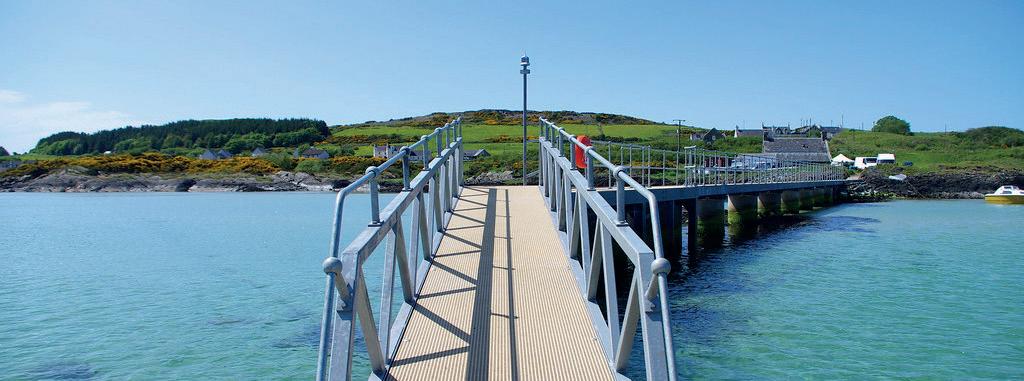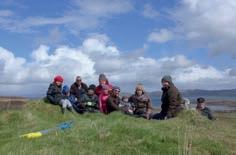
5 minute read
Community Buyouts
NEW COMMUNITIES
Two of the best-known examples of community landownership in Scotland involve the west coast islands of Eigg and Gigha. Craig Angus spoke to some of those involved to discover what life is like a few years on from the heady days of headlines and deadlines
Left, top: Gigha; bottom: Eigg, right: Isle of Gigha Heritage Trust M aggie Fyffe has a wonderful laugh. A joyful rasp, heartily deployed whenever she drops a memorable anecdote, which happens frequently. The secretary for the Isle of Eigg Heritage Trust (‘I am trying to retire’, she insists, ‘but it’s proving quite difficult’) has a lot of stories to tell about her 44 years on the island.
It’s impossible not to politicise the notion of community ownership. For some, the idea of idyllic Scottish islands remaining the property and plaything of multi-millionaires is in itself anathema. The reality is more complicated, however; a straw poll of residents would suggest there have been good ‘owners’, well-meaning types who have, in time, struggled to invest. And then there’s the Isle of Eigg, with a cast of villains and eccentrics you couldn’t make up if you tried.


Fyffe and her husband, Wes, were working at a craft centre in Banff when they first met Eigg’s then owner Keith Schellenberg. ‘He turned up at the place we were involved with’, she recalls, ‘and decided that he needed us on Eigg.’ Then comes that laugh again. ‘He instantly regretted it!’ Schellenber's antics are well-documented – humiliating, disrespectful and, above all, neglectful – though this is all in the past now. Eigg was bought by the Heritage Trust in June of 1997 after the bizarre, fleeting stewardship of the German artist Maruma. ‘We had a go at working with him’, Fyffe says, ‘but he visited Eigg for a total of four days in the four years he owned Eigg, and he never replied to a single thing we sent him, most of which were really big issues.’
These days Eigg is a vibrant place, featured on television programmes and held up worldwide as a shining example of community ownership done well. ‘There’s always half a million things going on,’ Fyffe says of an island that boasts a brewery, Laig Bay, a music festival, Howlin' Fling, and and a thriving tourism industry that sees the island welcome visitors from far afield. ‘We’ve our very own Extinction Rebellion group, we’re working on an EU project around clean energy, we’re working with a group of other communities on our electricity supplies,’ says Fyffe, before detailing an extensive operation called Timber Eiggxport, a collaborative effort with the Knoydart Foundation, which will provide the islanders with three to five years worth of firewood. Then there’s the Pier Centre Am Laimhrig. ‘We’ve seriously outgrown it, so we’re trying to build an extension. It’s going to cost an awful lot of money so we’re just waiting to hear about funding. We built it in 1998 and we thought it was the best thing ever at the time! But the population has nearly doubled and the number of visitors has doubled, if not more.’
It’s no great surprise to hear that the fun-loving Fyffe was in Gigha back in 2002 for that island’s own independence celebrations, having followed the example of Eigg to pay £4 million via its own heritage trust to purchase the island from the businessman Derek Holt. I had been there myself for two summer holidays in 2000 and 2001. Returning in 2016 to visit the post-buyout community, I was immediately struck by how much had changed around Ardminish, where the ferry comes in from Tayinloan on the mainland.
Jane Clements was raised on Gigha along with her nine siblings at Tarbert Farm, which is still run by her family today under the name Wee Isle Dairy, producing renowned whole milk and ice cream. Clements currently serves as the voluntary board director of the Isle of Gigha Heritage Trust, and has witnessed the changes on the island firsthand, noting a shift away from traditional agricultural industries and a push towards the economic diversification that an island community like this needs to thrive. ‘There were nine dairy farms at one point, says Clements, ‘and now there’s only two dairy farms and two beef/sheep farms. We’ve had a lot of businesses come to Gigha though: the Gigha Halibut farm, Gigha Oysters and the Scottish Salmon Fish Farm that has grown a lot over the last few years and is the biggest employer on the island. There are three craft units that currently operate as a tearoom, a gallery and as the base for Gigha Natural Skin Care. The Trust owns the hotel, the shop and post office and the Boathouse Restaurant, however these are all leased out – offering more independent business opportunities.’
The number of tourists coming to the island is increasing too, as more accomodation becomes available. Clements estimates that 10,000 visitors come to the island annually from all over the world. ‘The tourism season on Gigha is stretching, starting around Easter time and lasting until the end of October. We’ve more outdoor enthusiasts including walkers, campers and those that love landscape photography.’
A big challenge faced by communities such as Gigha and Eigg is retaining a young, dynamic population. Fyffe says that, post-buyout, Eigg has already noticed a change. ‘Although there are new residents who have moved here (Fyffe cites Dean Wiggin, currently a member of the island’s forestry team, who somewhat mysteriously "arrived in a kayak and never left"), quite a few of our younger generation have moved back too. They started seeing things happening. I think if people are thinking about having kids, or have just had kids, they want the same kind of childhood as they had.’
Over on Gigha, the 20-year-old son of Jane, Brandon Clements, joined the board as a voluntary director last year and has been instrumental in communicating the needs of young people on the island, highlighting a requirement for more housing, so those who wish to remain and work on the island, while living independently, may do so. With developments like these, and more besides, Jane Clements is excited about the future for Gigha. ‘What keeps me on Gigha is my family connections and the opportunities available for the community. I am also very much invested in the aspirations for the future of the island. Although the community might not all see eye to eye all the time, we keep the focus on the sustainability of the island.’











